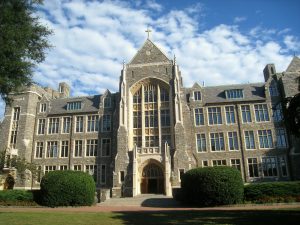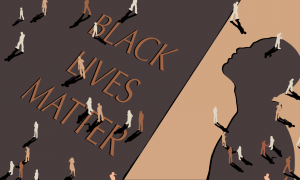Georgetown’s series of discussions about racial justice continued with three events dedicated to different aspects of the struggle toward racial equality in this country.
The events, which occurred between July 16 and July 30, concerned the place of Black women in the political arena, racial injustice and economic disparities in D.C., and to cap it off, an examination of how activism has evolved to meet the current moment.
Pairing faculty colleagues again with moderators, Vice President for Diversity, Equity, and Inclusion Rosemary Kilkenny bookended each session and promised a continuation of these conversations as the coming academic year begins.
Black women as voters, candidates, and officeholders
The first event in the second half of the series explored the roles Black women play in the political system. Voter turnout among Black women has been consistently high for half a century, creating one of the most stable demographic voting blocs. In addition to being an election year, 2020 also marks the 100-year anniversary of the ratification of the 19th Amendment ensuring women’s suffrage. In recent days, presidential candidate Joe Biden also announced his running mate: Kamala Harris, the first Black woman (and South Asian woman) to appear on a major party ticket.
Assistant Government Professor Jamil Scott spoke with American Government Professor Michele Swers in a discussion moderated by Professor and Faculty Director of the master of policy management program at the McCourt School of Public Policy Lynn Ross. Ross guided the conversation through each of the three levels of political participation.
Scott attributed high voter turnout among Black women to three main factors: a sense of duty that accompanies voting, the collective memory of the civil rights movement and following enfranchisement, and a desire to see change. The factors are weighted differently among different generations, according to Scott, who noted that some young voters will only remember the Obama administration and the current administration but lack longer institutional memory.
The conversation then moved on to the 2018 midterm elections, a banner year for women in general and women of color in particular running as candidates at the state and national level.
Part of the obstacle to such campaigns in the past, according to Scott, is funding. “I think that there is a question about finance; Black women don’t necessarily come from money communities,” she said, but “in 2018, there was a willingness and a visibility among Black women.”
Swers expanded: “There’s a reason why there are so many self-funded candidates, so many millionaires in Congress.” The cost of an average successful House campaign in 2018 came in at $2 million; the price of victory in the Senate the same year was more than $15 million. In an arena where deep pockets are the primary indicator of results, Swers explained that Black women, especially in districts that do not traditionally elect people of color, face a high barrier of entry.
Sometimes this obstacle even comes from within the party itself. Since the extension of the Voting Rights Act in 1992, “most of the Black women came from what are called ‘majority-minority’ districts,” she said. In 2018, however, women of color began to run, and win, in white-majority districts as well. “You saw some women deciding, maybe I don’t want to wait my turn. Some of these women that emerged were not the choice of the party.”
Swers continued that options for Black women as candidates may be further limited by the overwhelming precedent that Black women only run as Democrats. In fact, only one Black woman has ever served as a Republican in Congress: Mia Love, who narrowly lost her seat in 2018. Love was announced as one of GU Politics’ Fall 2020 fellows earlier this month.
While 2020 may not exceed the 2018 precedent, Scott still has hopes for further participation in the political sphere. “I don’t know if we can say 2020 will be as exciting as 2018. But I do think there will be more Black women running, and particularly given COVID-19 and the presidential performance, we might see a Democratic wave into 2020,” she said.
According to research Scott and her colleagues conducted, political participation in one area feeds participation in another; high voter turnout among Black women and participation in protest or advocacy work also increases the willingness of Black women to run for office. Furthermore, the Black women in office currently are helping to give others a shot at their open seat. “There have been some scholars who do work on women running right now, particularly at the state level, and what they’ve been finding is that Black women are shepherding in the new generation,” she said.
As officeholders as well, more Black women have now risen to leadership positions in the seniority hierarchy of the Congress.
And what they do with that influence, Swers said, sets them apart. “These women come in and they vote like other Democrats vote, but the issues that they champion are different,” Swers said. Scott added, “We see Black women take on other issues that may not look like women’s issues but in some way are related.”
To sustain this growth, Swers and Scott emphasized the importance of local action. The U.S. has never had a Black female governor, but these women are coming to occupy local positions that act as a pipeline for congressional and presidential hopes. Black women are now mayors in a number of major cities, and more positions of influence may not be far away.
Steady participation in political life and increased visibility and viability as candidates causes a knock-on effect of civic participation, according to Scott. To put it simply: “Women matter for other women.”
The manifestation of racial justice in income equality, gentrification and redlining
The second event in this half of the discussion series explored the vast disparities between white and Black populations in the nation’s capital. Kilkenny introduced the session citing examples of housing disparity and displacement in other areas: Native American reservations, displacement of Black residents to create Central Park in New York, and the displacement of 30,000 Black families during Atlanta’s preparation to host the Olympics. “For Black communities in urban areas, public policies have often been enacted under the guise of creating new public spaces,” Kilkenny said.
Assistant Professor of African American Studies Rosemary Ndubuizu engaged Director of the Race and Economic Empowerment Project James Benton—with Vice President for Government Relations and Community Engagement Christopher Murphy moderating—on the roots of income and housing inequality and their lasting impact on D.C. demographics.
“Housing is a cornerstone issue for the very reason that all of us need shelter,” Ndubuizu began. “Historically what has happened in the pursuit of shelter in a society that only gives shelter if you can pay for it, has been an active practice of sustaining housing inequities.”
A city long notable for its majority non-white population and high percentage of Black residents, the District has seen decades of decline in its Black population and widening disparities in housing. Any conversation about these inequalities necessarily begins with this nation’s history of racist homeownership policies, Ndubuizu argued.
She sketched a narrative of this history, looking back to the post-Depression initiative to make homeownership a backbone of economic recovery after a time when nearly a quarter of outstanding mortgages defaulted. Out of this effort, Ndubuizu said, came a mentality that equated the preservation of property value with the preservation of a predominantly-white racial composition of neighborhoods. “You had restrictive covenants to ensure ‘property value and neighborhood patterns,’ as they said, were preserved,” she said. In some cases, these restrictions are still listed on deeds of houses in the city to this day, even if they no longer have legal force.
Benton further explained the effects of these policies: “It is part of a series of policies that essentially lock out African-Americans from homeownership, that lock them out of owning homes in neighborhoods that are stable, lock them out of neighborhoods where prices appreciate or values appreciate.”
Redlining, a segregationist practice that takes its name from color-coded maps created by the Federal Housing Administration, may have been outlawed by the Supreme Court in 1948, but Benton said practices such as blockbusting, steering and the use of land contracts continued to disadvantage people of color for decades to come. Obstacles to homeownership also disrupted one of the primary ways wealth is inherited, through equity in homes or property, according to Murphy.
The panelists then transitioned to urban renewal projects in the second half of the 20th century. As D.C. lost roughly 60 percent of its white population between 1950 and 1970 in a phenomenon known as “white flight,” public officials sought to bring back families from the suburbs and recoup lost tax revenue.
“Urban renewal was an attempt to bring back white capital and white families,” Ndubuizu said.
Much of the same problem—namely, initiatives that do not aid Black residents—repeated with recent waves of gentrification in the capital. Residents below the poverty line tend to spend half their income on housing and utilities, a burden Benton fears will only increase with the additional burden of the COVID-19 crisis. “This housing crisis, caused by the public health crisis and leadership crisis, will lead to a homelessness crisis and flare-up in another public health crisis,” he said.
Ndubuizu also responded to questions about the touted benefits of gentrification, including a redistribution of the city’s revenue toward social programs. While this increased funding has its advantages, she said, “If the rents are going higher and higher, the likelihood you gain and benefit from these resources goes lower and lower.”
Benton emphasized that the housing issue is intimately connected to issues of employment and education. Policies of the past, even well-intentioned ones, have led to disastrous consequences, he said, and a more careful but urgent policy shift is the only way to make progress.
Benton closed with a question befitting of all these discussions: “How do you address 400 years of policy, white supremacy and discrimination and build a truly multiracial democracy?”
Political and social activism in the Trumpian era
The final discussion in this racial justice series revolved around activism and change-making in the current political and social climate. Law Professor Anthony Cook and Soyica Colbert, professor of African American Studies and Performing Arts as well as vice dean of faculty and director of arts initiatives, drew comparisons between protests in 2020 and the oft-cited civil rights movements of the 1960s.
The session, held on the day of the late Rep. John Lewis’s funeral, began with a related question from moderator Lisa Brown, general counsel: “How do you define good trouble?”
Cook and Colbert each began by explaining their theories of how activism works. Cook posited what he sees as three separate spheres of activism: political, which concerns policy and law; economic, which focuses on transactional relations and equity; and socio-cultural, which concerns interpersonal relations, patterns of thought and behavior, media, education, and customs.
Colbert added, “I would also include in the idea of social activism: planning, rigorous study, community building, and organizing.” She said that protests raise awareness, but truly lasting change comes from solid organizational foundations, especially in the fight for racial justice.
Citing Black author Lorraine Hansberry, Colbert offered a simple definition of activism as the way in which individuals change their environment. “Societies are built through our daily activities; structures are sustained by individual people. What Hansberry understood is that the quotidian everyday activities we participate in can dismantle structures or build new ones,” she said.
This individualized approach to making change emerged in the aftermath of the civil rights movement. “We used to think of activism as being the province of certain special, charismatic leaders,” Cook said, “and what we saw coming out of the civil rights movement was that activism needed to be more decentralized, more democratized.” The racist systems ingrained in everyday life necessitates people from all walks of life to become leaders and activists, he continued.
Colbert reacted to the continuous police violence at protests across the country, saying, “Even in the moments we herald as moments of possibility, for activists, those moments are always overshadowed by violence.” She noted that the 1963 March on Washington was followed a few weeks later by the bombing of Birmingham’s 16th Street Baptist Church, where white supremacists killed four Black schoolchildren.
The connections between racial injustice, economic inequality and unequal access to services mean that the struggle is not over, and will likely continue for a long time to come, according to Cook, who emphasized the need for moments of hope and renewal to continue fueling progress. “Even when fatigued, as sometimes happens in a movement that has such longevity, you’ve got others who can hold up the banner and keep the pressure on,” he said.
“The Black freedom struggle in America is long-term and ongoing. Freedom still eludes us.”





